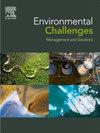城市雨水集水区微塑料丰度和类型的对比与时间分析
Q2 Environmental Science
引用次数: 0
摘要
城市地区的雨水是众所周知的将塑料和微塑料污染输送到世界海洋的途径。然而,与海洋环境相比,城市雨水系统中微塑料丰度的研究仍然有限且研究不足。此外,微塑料丰度的时间变化很少被考虑,大多数研究只报告了一次采样事件。本研究考察了微塑料颗粒(>;20 μm和<;5 mm)的时间分布和聚合物类型。位于澳大利亚悉尼Centennial Parklands的三个池塘在八周的时间里进行了采样,这些池塘接收来自不同城市雨水集水区的雨水。共收集了1511个颗粒,并根据形状和聚合物类型进行了鉴定。水样中微塑料颗粒丰度为3.1 ~ 11.9粒/L。结果表明:不同周池间塑料颗粒数量和类型无显著差异;然而,它们表明,百年公园内的池塘受到各种微塑料的均匀污染。在悉尼这些城市湿地中发现的微塑料丰度高于类似城市化地区的报告。氯化聚乙烯是所有取样池塘中最常见的聚合物,占颗粒的64%至97.5%,而碎片是取样期间观察到的最常见的微塑料颗粒形状。需要对微塑料进入环境的时间进行调查,以制定有效的管理和缓解战略。建议对雨水中的微塑料进行长期和持续的监测,以准确估计其对全球微塑料污染的贡献。本文章由计算机程序翻译,如有差异,请以英文原文为准。

Comparative and temporal analysis of microplastic abundance and type in urban stormwater catchments
Stormwater from urban areas is a well-known pathway for the transportation of plastic and microplastic pollution to the world’s oceans. However, research on microplastic abundance in urban stormwater systems is still limited and understudied compared to the marine environment. Further, temporal changes in microplastic abundance are rarely considered with the majority of studies reporting on one sampling event only. This study investigated the temporal distribution and polymer type of microplastic particles (>20 μm and <5 mm). Three ponds located in Centennial Parklands, Sydney, Australia, that receive stormwater from different urban stormwater catchments were sampled over an eight-week period. A total of 1511 particles were collected and identified according to shape and polymer type. The abundance of microplastic particles in the water samples ranged from 3.1 to 11.9 particles/L. The results showed no significant difference in plastic particle count and type among the ponds from week to week; however, they indicate that ponds within Centennial Parklands are homogeneously polluted with a variety of microplastics. The abundances of microplastics found in these urban wetlands of Sydney were higher than those reported in areas of similar urbanization. Chlorinated polyethylene was the most common polymer in all sampled ponds, at 64 % to 97.5 % of particles, while fragments being the most common microplastic particle shape observed during sampling. Temporal investigation of microplastic transport into the environment is needed to develop effective management and mitigation strategies. Long-term and ongoing microplastic monitoring in stormwater is recommended to derive an accurate estimation of its contribution to global microplastic pollution.
求助全文
通过发布文献求助,成功后即可免费获取论文全文。
去求助
来源期刊

Environmental Challenges
Environmental Science-Environmental Engineering
CiteScore
8.00
自引率
0.00%
发文量
249
审稿时长
8 weeks
 求助内容:
求助内容: 应助结果提醒方式:
应助结果提醒方式:


